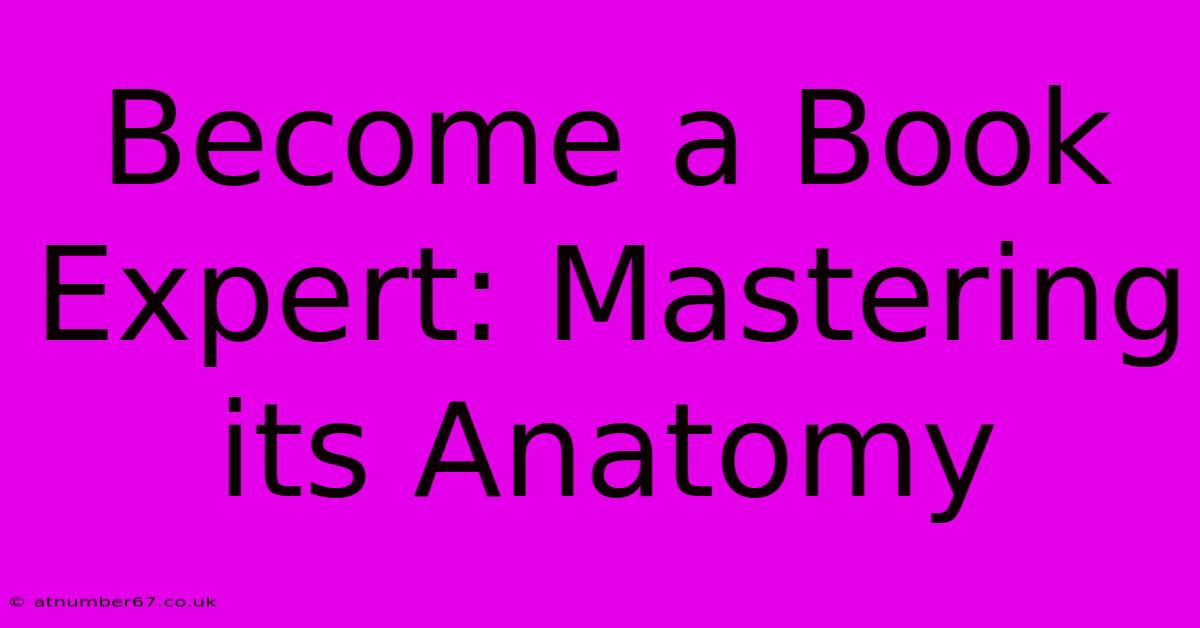Become A Book Expert: Mastering Its Anatomy

Table of Contents
Become a Book Expert: Mastering its Anatomy
Want to truly understand books, not just as a reader, but as a creator, editor, or even a discerning collector? Then mastering the anatomy of a book is crucial. This guide delves into the essential components, revealing the hidden structure and craftsmanship that makes a book more than just words on paper. Understanding this intricate design will elevate your appreciation and enhance your abilities, whether you're crafting your own manuscript or simply wanting to become a more knowledgeable book lover.
Understanding the Physical Structure: From Cover to Cover
A book's physical structure, its tangible form, is far more complex than it initially appears. Let's break down the key elements:
1. The Cover: First Impressions Matter
The cover is the book's face, its first and often lasting impression. It’s more than just pretty artwork; it's a crucial marketing tool. Key components include:
- Dust Jacket (or Jacket): The outermost layer, often featuring the title, author's name, blurb, and striking visuals. This is the first thing a potential reader sees.
- Cover Boards: The protective layer beneath the dust jacket, providing structural integrity. These can be made of various materials, influencing the book's feel and cost.
- Spine: The backbone of the book, containing the title, author's name, and sometimes publisher information. This is critical for shelf organization and identification.
2. The Interior: Where the Magic Happens
Once you move past the cover, you enter the heart of the book – the interior. This section holds the narrative and the subtle design choices that greatly enhance the reading experience:
- Endpapers: The pages that glue the cover boards to the text block. These can be plain or decorated, sometimes adding another layer of design.
- Title Page: Officially introduces the book's title, author's name, and publisher information.
- Copyright Page: Contains legal information, including copyright details, ISBN, and publishing information.
- Dedication: A personal message from the author, often found following the copyright page.
- Preface/Foreword/Introduction: Provides context and background information for the book.
- Text Block: The main body of the book, containing the chapters, text, and illustrations.
- Chapter Openings: Often visually distinct, marking the start of a new section.
- Illustrations/Photographs: Enhance the text, providing visual context or aesthetic appeal.
3. Binding: Holding it All Together
The binding method significantly impacts the book's durability and overall presentation. Common methods include:
- Perfect Binding: Pages are glued together along the spine, creating a flat spine. Often used for paperback books.
- Saddle Stitch Binding: Pages are folded and stapled through the spine. Used for booklets and magazines.
- Case Binding: Sections of pages are sewn together, creating a more durable binding. Commonly used for hardback books.
Beyond the Physical: The Literary Anatomy
While the physical aspects are important, understanding the literary structure is equally crucial for becoming a true book expert. This encompasses:
- Plot Structure: The sequence of events, including exposition, rising action, climax, falling action, and resolution.
- Character Development: How characters evolve and change throughout the narrative.
- Narrative Voice & Point of View: The perspective from which the story is told.
- Theme & Motifs: The underlying message or recurring symbols within the story.
- Genre Conventions: The established rules and expectations within specific book genres.
Becoming a Book Expert: Continuous Learning
Mastering the anatomy of a book is an ongoing process. Engage in continuous learning through:
- Reading widely and critically: Analyze different books, comparing their structures and styles.
- Exploring book design and publishing resources: Learn about typography, layout, and printing techniques.
- Connecting with other book enthusiasts: Share insights, discuss interpretations, and expand your knowledge.
By understanding the intricate details of a book—from its physical construction to its literary elements—you'll become far more than just a reader. You’ll become a true book expert, capable of appreciating the craftsmanship, understanding the storytelling, and ultimately, enriching your experience with the written word.

Thank you for visiting our website wich cover about Become A Book Expert: Mastering Its Anatomy. We hope the information provided has been useful to you. Feel free to contact us if you have any questions or need further assistance. See you next time and dont miss to bookmark.
Featured Posts
-
The Truth About Rachin Ravindras Age Revealed
Apr 02, 2025
-
Moms Pass Salary The Power Of Negotiation
Apr 02, 2025
-
The Impact Of Gautam Gambhir S Age On His Leadership
Apr 02, 2025
-
Doug Fregins Net Worth Setting Financial Aspirations
Apr 02, 2025
-
Tik Tok Galaxy Phone Deals Real Or Fake
Apr 02, 2025
